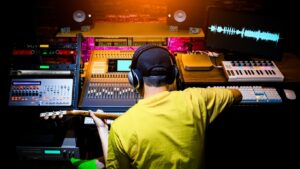 Capturing the perfect guitar sound in a recording can be both an art and a science. Whether a seasoned musician or a budding enthusiast, achieving a studio-quality guitar track requires more than just hitting the record button. With the right techniques, anyone can elevate their recordings from amateur to professional, ensuring every strum and pick resonates with clarity and precision. Understanding the nuances of microphone placement, room acoustics, and equipment selection is crucial in crafting the desired sound. Each element plays a pivotal role in the overall quality of the recording. By mastering these aspects, guitarists can unlock a world of sonic possibilities, bringing their musical visions to life. In this article, we’ll explore essential tips and tricks to enhance guitar recordings. From choosing the right gear to fine-tuning the final mix, these insights will help musicians create tracks that truly stand out.
Capturing the perfect guitar sound in a recording can be both an art and a science. Whether a seasoned musician or a budding enthusiast, achieving a studio-quality guitar track requires more than just hitting the record button. With the right techniques, anyone can elevate their recordings from amateur to professional, ensuring every strum and pick resonates with clarity and precision. Understanding the nuances of microphone placement, room acoustics, and equipment selection is crucial in crafting the desired sound. Each element plays a pivotal role in the overall quality of the recording. By mastering these aspects, guitarists can unlock a world of sonic possibilities, bringing their musical visions to life. In this article, we’ll explore essential tips and tricks to enhance guitar recordings. From choosing the right gear to fine-tuning the final mix, these insights will help musicians create tracks that truly stand out.
Guitar Recording Tips
Recording a guitar involves more than just hitting the record button. Quality hinges on the right choices in guitars, amps, and recording gear.
Selecting a Guitar and Amp
 Guitars and amps shape the foundation of the recorded sound. Choosing a guitar, factors include tonal quality and comfort. Electric guitars like the Fender Stratocaster or Gibson Les Paul offer distinct sounds. For acoustic recordings, a Martin or Taylor may produce rich harmonics. Amp selection is crucial for electric guitars. Tube amps provide warmth and depth, while solid-state amps deliver a cleaner tone. Brands like Marshall and Vox are popular among professionals. Pairing the right guitar with a compatible amp impacts the overall quality.
Guitars and amps shape the foundation of the recorded sound. Choosing a guitar, factors include tonal quality and comfort. Electric guitars like the Fender Stratocaster or Gibson Les Paul offer distinct sounds. For acoustic recordings, a Martin or Taylor may produce rich harmonics. Amp selection is crucial for electric guitars. Tube amps provide warmth and depth, while solid-state amps deliver a cleaner tone. Brands like Marshall and Vox are popular among professionals. Pairing the right guitar with a compatible amp impacts the overall quality.
Essential Recording Gear
A seamless recording setup includes essential gear. Interface selection depends on input needs, with brands like Focusrite and Universal Audio offering reliable options. High-quality microphones capture nuanced sound, with Shure SM57 for electric and Neumann KM184 for acoustic guitars being standard choices. Monitoring is enhanced using closed-back headphones for detailed listening. DAW (Digital Audio Workstation) options like Pro Tools and Ableton Live support mixing with advanced features. Quality cables reduce noise and interference, ensuring a clean signal throughout the recording chain.
While recording focuses on capturing the perfect tone, practical accessories aid the process. Music folders are essential for guitarists, keeping lyrics, chord charts, and notes organized during recording sessions. This reduces disruptive searches and allows for smoother takes, ensuring the focus remains on performance and achieving that ideal sound for every track.
Setting Up Your Recording Space
Creating an ideal recording environment plays a pivotal role in capturing high-quality guitar sounds. Proper setup significantly influences the clarity and overall tone of the recording.
Acoustic Considerations
Room acoustics impact the sound quality in recordings. Small, reflective spaces often introduce unwanted echoes and distortions. To minimize these, using acoustic panels or blankets to absorb sound reflections is beneficial. Soft furnishings like curtains and rugs can further dampen harsh frequencies. Aim to create a balanced acoustic environment where natural resonance isn’t overwhelming.
Optimal Mic Placement
 Mic placement affects how a guitar’s sound is recorded. For electric guitars, positioning the microphone between the center and edge of the amplifier’s speaker cone captures a balanced tone. Slight angle adjustments can tailor the sound further. With acoustic guitars, placing a microphone approximately 12 inches from the 12th fret often achieves a natural, warm tone. It’s crucial to experiment with distances and angles to find the optimal setup for the desired sound.
Mic placement affects how a guitar’s sound is recorded. For electric guitars, positioning the microphone between the center and edge of the amplifier’s speaker cone captures a balanced tone. Slight angle adjustments can tailor the sound further. With acoustic guitars, placing a microphone approximately 12 inches from the 12th fret often achieves a natural, warm tone. It’s crucial to experiment with distances and angles to find the optimal setup for the desired sound.
Recording Techniques
Recording techniques significantly impact the final quality of guitar tracks. Musicians explore various approaches to capture authentic and professional sound.
Direct Input vs. Microphone Recording
Direct Input (DI) recording involves connecting an electric guitar directly to an audio interface. It offers a clean signal, flexibility in post-production, and is less susceptible to acoustic interference. DI proves useful when using amp simulation software or requires a pristine noise floor.
Microphone recording captures the natural ambiance of a guitar amplifier or an acoustic instrument. It requires careful mic placement and an acoustic-friendly environment. This method adds warmth and depth, making it ideal for achieving an organic, rich sound.
Double-Tracking Guitars
Double-tracking enriches the guitar’s tonal palette by recording two separate performances of the same part. Pan each track hard left and right in the mix to create a full, stereo sound. Ensure precise timing to avoid phasing issues that can inhibit clarity. Artists often use this technique to add fullness and complexity, enhancing the overall sonic experience.

